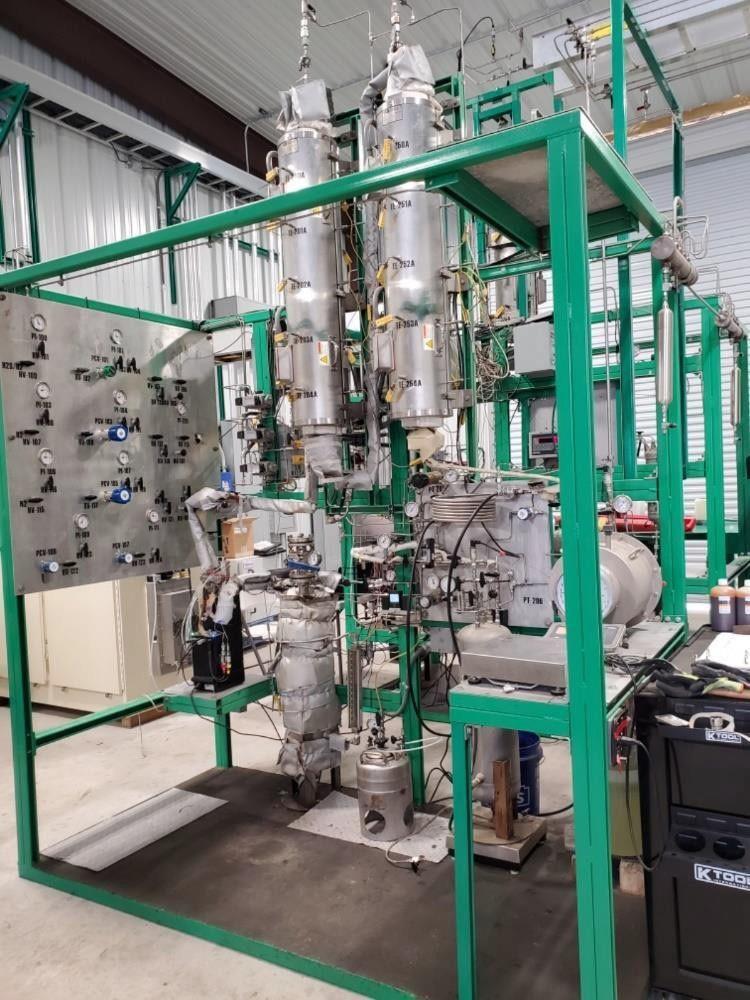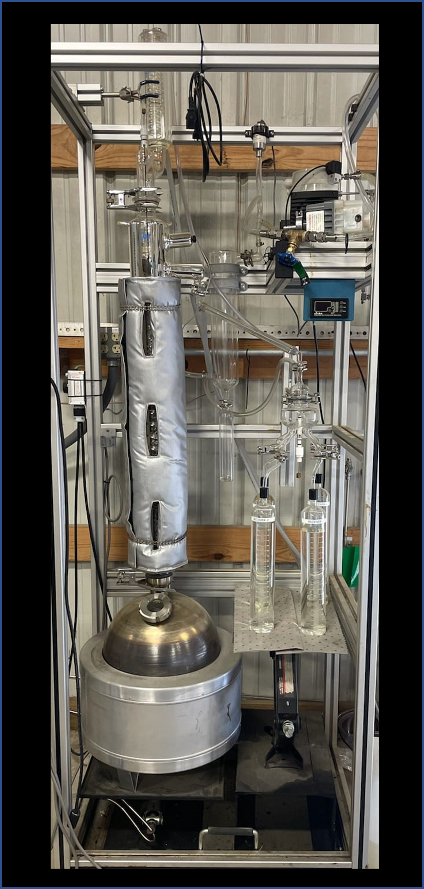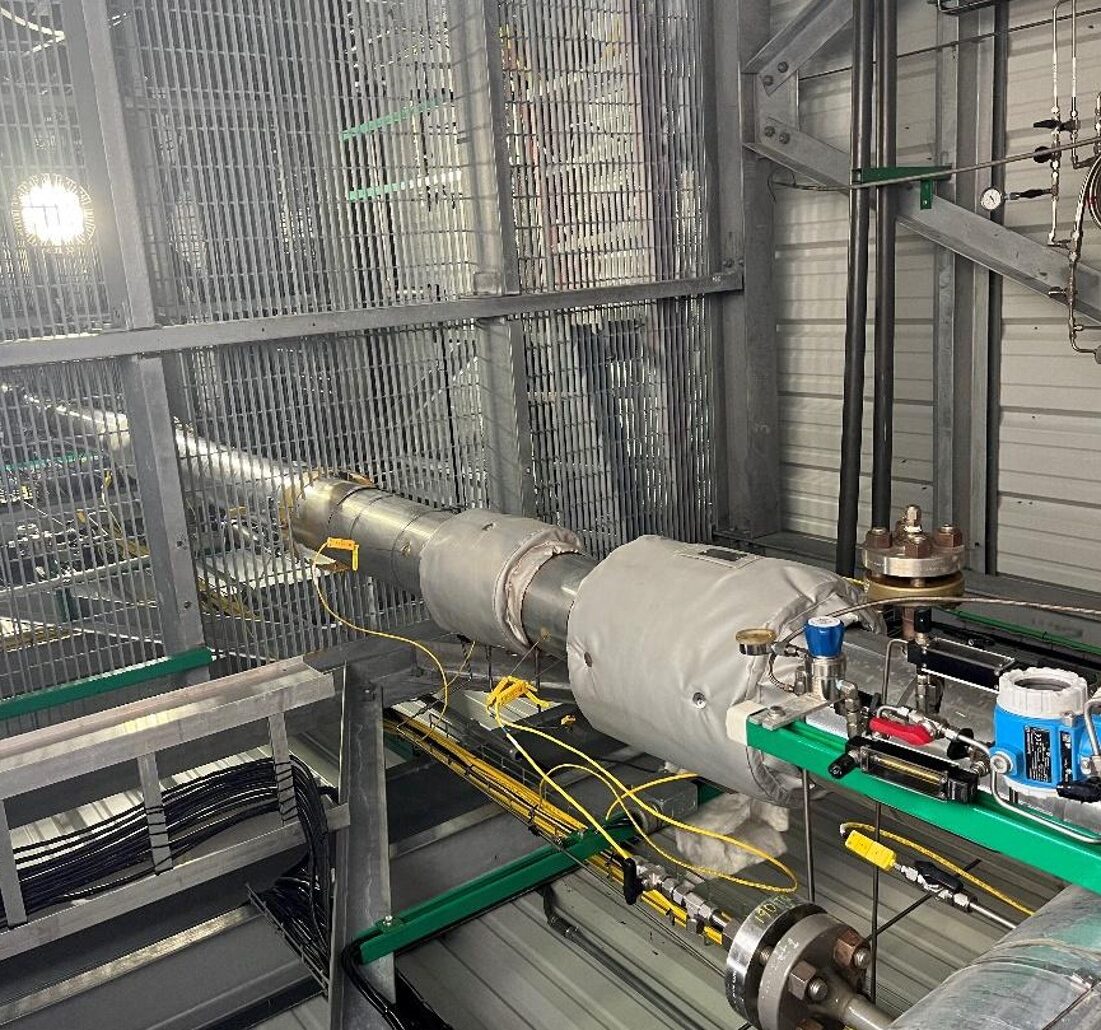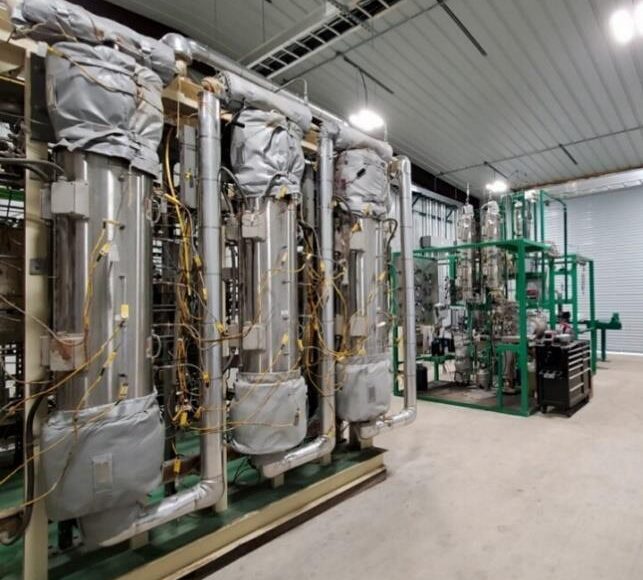RPD has existing pilot infrastructure to support a wide range of applications. While some units are built for client specific objectives, others are used for general testing purposes. RPD’s pilot and demonstration fixed bed/hydroprocessing and distillation units can be adapted to a wide range of processes. In addition to fixed bed and distillation capabilities, RPD has additional general use capabilities including filtration, blending, stirred tank reactors among others.
Fixed Bed/Hydroprocessing and Distillation Capabilities
Fixed Bed/Hydrotreating Pilot Units
RPD currently operates three fixed bed/hydrotreating units that can accommodate a wide range of process conditions including operation at temperature and pressures up to 425 oC and 2500 psig. The pilot feed stations accommodate both liquid and vapor feedstocks. Gases are fed through compressed gas cylinders connected to thermal or Coriolis mass flow controllers, where typical ranges for vapor feeds including N2 and H2 are 0-300 g/hr. Liquid feedstocks are stored in 5- 20 gallon stainless steel vessels and are fed to the system via metering pump(s) having an operating range of 0.00003-97 ml/min. These metering pumps are equipped with a dual cylinder housing for continuous and uninterrupted flow. Process feeds are generally provided by the client, however RPD can source the startup fluid and/or sulfiding agent(s) as needed. Feed and product tanks are equipped with the appropriate heating arrangement to reduce viscosity as necessary.
The reactor section consists of two reactors arranged in series, heated with multi-zone clam-shell furnaces. Process and reactor skin temperature measurements are recorded and controlled at each zone to maintain the temperature profile required by the client (either adiabatic or isothermal) and are connected to the interlock / safety system. Process pressure is monitored upstream and downstream of the reactors and is also connected to the interlock / safety system. Several reactor options are available, including reactors made from ¾” sch 40, 1” or 1.5” nominal sch 80 pipe. The heated zone for each reactor is approximately 45”. Unit throughput typically ranges between 1 and 5 gallons per day.
The product section consists of a tube-in-tube heat exchanger to cool the reactor products followed by a back- pressure controller. Liquid products are collected in a stainless-steel product storage tank equipped with a N2 purge and are weighed daily. Effluent vapor from the product storage tank is quantified by Coriolis/wet test meter and/or N2 tracer, and then directed to vent or flare. Gas phase analysis of the product vapors is possible using RPD’s in house GC.

Operating conditions are generally provided by the client, and any variations to these conditions that are within the design parameters of the unit can be readily accommodated. The fixed bed/hydrotreater pilot units are designed to operate 24/7 with typical day shift coverage by operators and unattended night shifts.

Batch Distillation
RPD has a batch distillation unit consisting of a 50 mm diameter glass column that can be operated with up to ~15 theoretical stages. Batch flasks of 12L and 22L capacity are available with a minimum turndown of about 25% flask capacity. The unit is equipped with a reflux control valve where reflux ratio can be adjusted manually to match specific process requirements. The batch unit can operate at atmospheric and vacuum pressures where vacuum pressures of less than 1 torr are easily achieved. The unit has 4 1L receivers on the overhead so that different cuts of distillate can be collected and separated for analysis.
Continuous Demonstration Scale Distillation Unit
RPD operates a demonstration scale distillation unit made of 4” nom sch 40 SS316L pipe. The unit approximately 40’ tall and is typically loaded with random packing such as pall rings capable of approximately 20+ theoretical stages. The column loading and staging can be easily modified depending on client specifications. The unit can currently operate at a wide range of pressures ranging from 10 to 200 psig with both increased pressure (up to 600 psig) and vacuum capability capable of being added. The reboiler capacity is approximately 33kW (which can be increased) and the column has a reflux setup with condenser, overhead tank, reflux pump and reflux heater. Products can be withdrawn via an overhead distillate, bottoms or side draw stream(s) where the side draw can be located at 25, 50 and 75% of the column height. Based on past experiences, this unit can typically process between 50-150 lb/hr hydrocarbon feed rates. Each client’s process conditions are examined to better estimate the unit throughput prior to operation.
The demonstration scale distillation unit is designed to operate 24/7.


Demonstration Scale Fixed Bed/Hydrotreater
The demonstration fixed bed/hydrotreater consists of feed pump(s), a feed pre-heater, 6 reactors in series with heating capability, hot and cold knock out vessels, a product stripper to remove sour water and appropriate tankage for storage of feed and products. Two hydrogen compressors are available for makeup and recycle requirements and can both be configured for makeup requirements as necessary.
Feed rates to the demonstration unit can range between 10 and 200+ lbs/hr and may operate up to 2500 psig @ 425°C. The feed pumps are controlled using a VFD and have appropriate turn-down to cover the entire flow range and ability to achieve the required discharge pressure. The feed is mixed with the hydrogen treat gas and can be pre- heated close to target reaction temperatures with an electric heater prior to entering the first reactor.
The reactors are heated with clam-shell type furnaces and equipped with internal and external thermocouples to control temperature and prevent heat loss. Interstage tubing between the reactors is also heat traced and insulated to prevent heat loss. Reactor options include 5” sch 160 SS316/316L or 6” nominal sch 80 347H SS reactors with Grayloc connectors. Each reactor has a heated length of approximately 60”. A separate stand is used to load / unload or move the reactor. Hydrogen will be fed from tube trailers and compressed to reaction pressure. If required, recycle or makeup hydrogen can be introduced between each reactor to reduce the temperature before the inlet of each reactor. The demonstration scale fixed bed/hydrotreater is designed to operate 24/7.
Control System and Data Logging
All the units at RPD are controlled using PLCs that send data to centralized SCADA system which is used to monitor, control, trend and historize data. All the data is stored in a dedicated on-premise database which can be accessed easily to obtain and analyze run data at various time stamps.
Utilities
RPD has a utility supply including nitrogen, instrument air, cooling water supply, site flare and electricity supply. Based on the campaign requirements capacity of these utilities can be increased by adding rental equipment as needed.
Storage and Handling
RPD Technologies has proper storage and handling facilities per NFPA code for all process gases including compressed air, nitrogen, and flammable gases like hydrogen. Process liquids are stored in dedicated long term storage areas or near the unit with proper labelling as required. Any product shipped from site requires proper SDS documentation and follows DOT guidelines. All feed and products are stored indoors or under covered structures at ambient conditions.
Process Waste
Off gases from processes are sent to the site flare system. The flare system incorporates a flame arrestor and quench system to handle highly flammable gases, specifically those associated with high hydrogen content vapors. Other wastes are collected and sent off to a local hazardous waste facility for treatment and proper disposal. Process emissions and waste currently fall under RPD’s existing permitting limits.
Analytical System
Customers of RPD have the option of using several local labs for analytical testing. On site analytical capabilities include vapor phase GC (RGA: H2, N2, C1-C6), Karl Fischer and density in addition to any other potential equipment that may be rented or purchased/provided by the client. Sampling procedures and schedule are discussed with the client prior to start of the pilot campaign. Process and analytical data are uploaded or emailed to the client at regular intervals for their monitoring and analysis.
Safety Protocol
RPD follows PSM based safety protocols to manage process safety at site. Process design and operations must go through a safety review and approval before any construction and or operation can begin. Once the process is under construction or operation, all changes are subject to a Management of Change protocol.
